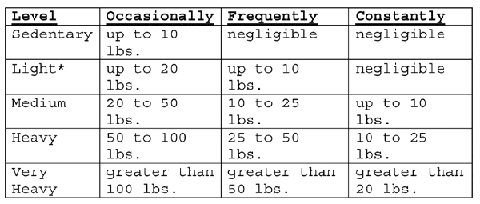Vocational Issues in Social Security Disability
There are a limited number of vocational issues in a Social Security disability case. They are:
1. What are the physical and mental demands of the claimant’s past relevant work as the claimant performed it?
A vocational expert (VE) is probably not necessary to answer this question. A Social Security regulation provides that “statements by the claimant regarding past work are generally sufficient for determining the skill level, exertional demands and nonexertional demands of such work.”
However, if a vocational expert is present at the hearing, the VE will probably be asked to describe your past relevant work. The regulations provide that a “vocational expert or specialist may offer relevant evidence within his or her expertise or knowledge concerning the physical and mental demands of a claimant’s past relevant work, either as the claimant actually performed it or as generally performed in the national economy. Such evidence may be helpful in supplementing or evaluating the accuracy of the claimant’s description of his past work.”
2. What are the physical and mental demands of the claimant’s former job as generally required by employers throughout the national economy?
This issue comes up if you are unable to do any past job as the you actually performed it, but a past job involved functional demands and job duties significantly in excess of those generally required for that job by other employers.
You will be found not disabled if you retain the capacity to perform the job as ordinarily required by employers throughout the national economy.
3. Can the claimant meet the demands of the claimant’s previous work, either as the claimant actually performed it or as generally performed in the national economy?
The regulations provide that “a vocational expert or specialist may offer expert opinion testimony in response to a hypothetical question about whether a person with the physical and mental limitations imposed by the claimant’s medical impairment(s) can meet the demands of the claimant’s previous work, either as the claimant actually performed it or as generally performed in the national economy.”
4. Does the claimant have skills that are transferable to a significant range of work?
The issue of transferability of work skills is a complicated one made relevant in some cases by the Medical-Vocational Guidelines.
This issue does not come up very often.
Even if it is determined that there are no transferable skills, younger claimants may be denied benefits based upon the capacity for unskilled work. In those cases involving claimants age 50 and over where transferability matters, there are different standards based on age for determining whether or not skills are transferable.
5. Is the claimant capable of performing other work? Do jobs exist in significant numbers within the claimant’s RFC considering age, education and work experience? That is, is vocational adjustment possible to other work?
This issue includes the questions: For a literate, English speaking claimant under age 50, how many jobs are available to a claimant with a particular residual functional capacity? For the rest, how much of the claimant’s occupational base has been eroded by his or her impairments?
These issues come up when the Medical-Vocational Guidelines do not direct a conclusion that you are or are not disabled.
For the Medical-Vocational Guidelines to be used, your RFC, education and work experience must coincide with the criteria of one of the rules in the Guidelines. Where there is no close fit between your characteristics and the Medical-Vocational Guidelines, the Guidelines must be used as a framework for determining the interaction of your remaining occupational base with the other factors affecting capability for occupational adjustment—age, education and work experience.
The Government’s Vocational Expert
If your case involves a vocational issue then a vocational expert (VE) may be scheduled to testify. This expert is most likely to be appointed by the Administrative Law Judge (ALJ), but sometimes your attorney may have an opportunity to have your own VE testify or provide a written opinion.
Vocational experts testify at the request of the Social Security Administration in many more Social Security disability hearings than do medical experts. However, the experience, knowledge, ability, understanding of the VE role, and the prejudices of individual VEs vary much more widely than do the skills and experience of medical experts. Your attorney will probably not be pleased to receive a notice that a government vocational expert will be testifying at your hearing.
The primary purpose of vocational expert testimony is to meet the Social Security Administration’s burden of proof in denying disability benefits. However, this may not be the motivation of an individual ALJ. Generally the presence of a VE at a disability hearing means that the ALJ has reviewed the hearing exhibits and concluded that you cannot do past work, at least as you actually performed it, and that the case is not one in which benefits can be granted or denied using the Medical-Vocational Guidelines alone.
The vocational expert is supposed to address the vocational issues created by the Social Security Act and the Medical-Vocational Guidelines. The Social Security Act provides that a claimant “shall be determined to be under a disability only if his physical or mental impairment or impairments are of such severity that he is not only unable to do his previous work but cannot, considering his age, education and work experience, engage in any other kinds of substantial gainful work which exists in the national economy . . . in significant numbers.”
The Medical-Vocational Guidelines were designed to address two things:
(1) whether jobs exist in significant numbers for certain combinations of residual functional capacity (RFC), age, education and work experience.
(2) to set the parameters for assessing the impact of age, education and work experience in those cases where the rules themselves do not direct a conclusion whether a claimant is or is not disabled.
If you are under age 50 (or under age 45 if illiterate or unable to communicate in English), the job of the vocational expert is to determine how many jobs you are capable of doing based on the your residual functional capacity. If you are capable of performing a “significant number” of jobs, then you are not disabled. Age, education and work experience really do not enter into this calculation.
It is the decision-maker’s job to determine what a “significant number” is.
The Medical-Vocational Guidelines say that a claimant with the same age, education and work experience will be found disabled if limited to sedentary work, but if he were capable of a full range of light work he will be found not disabled.
An ALJ needs to consult a vocational expert “where the extent of the erosion of the occupational base is not clear” and the claimant’s exertional capacity falls between two rules from the Medical-Vocational Guidelines that dictate opposite conclusions.
In recent years, when the Medical-Vocational Guidelines are not directly applicable, the role of the vocational expert in assessing the case of a claimant over age 50 is simply to offer an opinion about the number of jobs in the economy that the claimant is capable of performing. Then, it is up to the ALJ to determine whether this is a “significant number.” Although ALJs tend to take an “I know a significant number when I see one” approach, the regulations require “full consideration to all relevant facts in accordance with the definitions and discussions under vocational considerations,” and “full consideration must be given to all of the relevant facts in the case in accordance with the definitions and discussions of each factor in the appropriate sections of the regulations, which will provide insight into the adjudicative weight to be accorded each factor.”
Testimony from a Vocational Expert
ALJs usually do not ask any Vocational Experts questions about vocational adjustment or erosion of the occupational base. The questions ALJs usually ask are:
1. What are the skill and exertional levels of the claimant’s past job as the claimant actually performed it?
2. What are the skill and exertional levels of the claimant’s past job as generally required by employers throughout the country?
3. Assuming that the claimant is capable of [describe hypothetical RFC findings, etc.], is the claimant capable of returning to past relevant work?
4. [Where the issue of transferability of skills is critical:] If the claimant has the following residual functional capacity: [insert RFC], and the claimant is incapable of performing his skilled (or semi-skilled) past relevant work, does the claimant have any acquired skills that are transferable to some other skilled or semi-skilled work?
If yes,
- list the transferable skills;
- identify the jobs to which these skills transfer; and
- state the number of these jobs in the local and national economy.
5. [Where the Medical-Vocational Guidelines do not direct a conclusion of whether the claimant is or is not disabled:] Assuming that the claimant is unable to perform the prior work of [insert description of PRW], that the claimant has no transferable work skills, that the claimant’s educational level is [insert educational level], and that the claimant’s residual functional capacity is [insert RFC], is the claimant capable of performing other work?
If yes,
- identify the jobs; and
- state the number of these jobs in the local and national economy.
Vocational experts “should give full and complete answers to the questions posed by the ALJ and should not volunteer information.” They are expected to testify “only on vocational issues and only on those vocational issues which are relevant to the requirements of the statute, regulations and rulings.”
A VE is not supposed to:
- Provide his or her own evaluation of the medical evidence.
- State whether you are a proper candidate for vocational rehabilitation.
- State whether you can compete with unimpaired individuals for available employment.
- State whether job vacancies exist or whether you would be hired for existing jobs.
- State whether you can perform in a specific occupation with the same degree of efficiency or productivity as individuals with less than severe or no impairments.
- State whether you are or are not disabled.
The Americans With Disabilities Act Has Different Requirements
A memorandum to staff and judges from the Associate Commissioner of the Social Security Administration emphasized that the ADA and the disability provisions of the Social Security Act have different purposes, and have no direct application to one another. For example, the ADA defines “disability” in relation to the ability to perform what it describes as “major life activities.” Therefore, the term is not synonymous with “disability” as defined in the Social Security Act.
The Dictionary of Occupational Titles (DOT)
The Dictionary of Occupational Titles (DOT) contains brief descriptions of 12,741 occupations. There is a close link between the DOT and Social Security regulations. The DOT provided the definitions of exertional and skill levels in the regulations; and the grids, the individual charts based on exertional levels in the Medical-Vocational Guidelines, are based on the numbers of unskilled DOT occupational titles at each level of exertion.
Vocational experts are expected to be familiar with the DOT. The Social Security Administration relies on the DOT and other publications, even though the DOT is out of date (it was last revised in 1991). The Department of Labor has stopped revising the DOT and is replacing it with the O*Net, which has virtually no useful information for disability determination using the current sequential evaluation process.
The Social Security Administration has told decision-makers that when making disability decisions, they are not to rely on the O*Net.
In addition, a Social Security regulation provides that if vocational expert testimony conflicts with the DOT, the ALJ must obtain a reasonable explanation and set forth in the decision how the conflict was resolved.
Physical Exertion Levels
The classification of physical exertion levels used by the Social Security Administration is the same as in the Dictionary of Occupational Titles. However, the work levels published by the Department of Labor in the DOT have changed since the Social Security regulation was first published. The work levels stated in the Social Security regulations, which coincides with earlier editions of the DOT, may be summarized as follows:

Sedentary jobs involve sitting; walking and standing are required occasionally. When walking or standing are involved to a significant degree, the job is classified as light even when the weight lifted is negligible. A job is also classified as light when it involves sitting most of the time with a degree of pushing and pulling of arm and/or leg controls.
The 1991 revised edition of the DOT uses different definitions of exertional levels, which recognizes that constant lifting increases the exertional level. These newer definitions may be useful in cases where your client’s past relevant work required constant lifting.

Occasionally: activity or condition exists up to 1/3 of the time.
Frequently: activity or condition exists from 1/3 to 2/3 of the time.
Constantly: activity or condition exists 2/3 or more of the time.
*The definition of Light Work used in the 1991 Revision includes the following notation:
Even though the weight lifted requirements may be a negligible amount, a job should be rated Light Work when it requires:
(1) walking or standing to a significant degree; or
(2) sitting most of the time but entails pushing and or pulling of arm or leg controls; and/or
(3) working at a production rate pace entailing the constant pushing and/or pulling of materials even though the weight of those materials is negligible.
DOT Specific Vocational Preparation and Skill Level
Social Security regulations define unskilled work as work that a person can usually learn to do in 30 days.
The DOT sets forth training time for jobs called “specific vocational preparation ” or SVP, which is the time it takes to develop the facility for average performance on the job. The different SVP levels correspond to the Social Security Administration’s definitions of unskilled, semi-skilled and skilled work in the following chart:

There are relatively few SVP 1 occupations found in the DOT. Here are the numbers of SVP 1 and SVP 2 DOT titles by exertional level (including the numbers of semi-skilled and skilled DOT occupational titles by exertional level):

Example of the Use of the DOT: Nurse Assistant
The DOT contains an “Alphabetical Index of Occupational Titles,” and includes the following entry.
355.674-014 NURSE ASSISTANT (medical ser.) alternate titles: nurse aide
Performs any combination of following duties in care of patients in hospital, nursing home, or other medical facility, under the direction of nursing and medical staff. Answers signal lights and bells, or intercom system to determine patients’ needs. Bathes, dresses, and undresses patients. Serves and collects food trays and feeds patients requiring help. Transports patients using wheelchair or wheeled cart, or assists patients to walk. Drapes patients for examinations and treatments, and remains with patients, performing such duties as holding instruments and adjusting lights. Turns and repositions bedfast patients, alone or with assistance, to prevent bedsores. Changes bed linens, runs errands, directs visitors, and answers telephone. Takes and records temperature, blood pressure, pulse and respiration rates, and food and liquid intake and output, as directed. Cleans, sterilizes, stores, prepares, and issues dressing packs, treatment trays, and other supplies. Dusts and cleans patients’ rooms. May be assigned to specific area of hospital, nursing home, or medical facility. May assist nursing staff in care of geriatric patients and be designated Geriatric Nurse Assistant (medical ser.). May assist in providing medical treatment and personal care to patients in private home settings and be designated Home Health Aide (medical ser.).
GOE: 10.03.02 STRENGTH: M GED: R3 M2 L2 SVP 4: DLU: 89
This tells you what a nurse assistant does. And if you decode the definition trailer (the material in italics), you can learn the physical demands of the job, the language or mathematics development (education and other training time) required, how long it takes to learn the job, and the last time this definition was updated.
The definitions for these codes show the following:
- The GUIDE FOR OCCUPATIONAL EXPLORATION (GOE) code number, useful in comparing similar jobs, is 10.03.02.
- Strength factor (STRENGTH) for the job is M or medium.
- The general education development (GED) for this job is 3 for reasoning, 2 for mathematical development, and 2 for language development.
- The specific vocational preparation (SVP) is 4.
- The job description data were last updated in 1989.
The meanings of these codes are:
Medium work is work that requires the following:
Exerting 20 to 50 pounds of force occasionally, and/or 10 to 25 pounds of force frequently, and/or greater than negligible up to 10 pounds of force constantly to move objects. Physical demand requirements are in excess of those for Light Work.
Reasoning 3 requires:
Apply commonsense understanding to carry out instructions furnished in written, oral or diagrammatic form. Deal with problems involving several concrete variables in or from standardized situations.
Mathematical Development 2 requires:
Add, subtract, multiply, and divide all units of measure. Perform the four operations with like common and decimal fractions. Compute ratio, rate, and percent. Draw and interpret bar graphs. Perform arithmetic operations involving all American monetary units.
Language Development 2 requires:
Reading: Passive vocabulary of 5,000-6,000 words. Read at a rate of 190-215 words per minute. Read adventure stories and comic books, looking up unfamiliar words in dictionary for meaning, spelling, and pronunciation. Read instructions for assembling model cars and airplanes. Writing: Write compound and complex sentences using cursive style, proper end punctuation, and employing adjectives and adverbs. Speaking: Speak clearly and distinctly with appropriate pauses and emphasis, correct pronunciation, variations in word order, using present, perfect, and future tenses.
The specific vocational preparation (SVP) of 4 means:
To perform this job a person must have over 3 months, up to and including 6 months, of training in vocational education, apprenticeship training, in-plant training, on-the-job training, or essential experience in other jobs.
From this information, you can determine whether this job qualifies as past relevant work.
In addition, this description may show why you cannot return to it (e.g., inability to lift 50 pounds, inability to stand and walk for extended periods, or inability to tolerate frequent job duty changes and emergencies).
Example of the Use of Materials that Supplement the DOT: Surveillance-System Monitor
The DOT provides the following:
379.367-010 Surveillance-System Monitor (government ser.)
Monitors premises of public transportation terminals to detect crimes or disturbances, using closed circuit television monitors, and notifies authorities by telephone of need for corrective action. Observes television screens that transmit in sequence views of transportation facility sites. Pushes hold button to maintain surveillance of location where incident is developing, and telephones police or other designated agency to notify authorities of location of disruptive activity. Adjusts monitor controls when required to improve reception, and notifies repair services of equipment malfunctions.
GOE 04.02.03. STRENGTH: S GED: R3 M1 L3 SVP: 2 DLU 86
Decoding the definition trailer shows the following requirements:
Reasoning 3 requires:
Apply commonsense understanding to carry out instructions furnished in written, oral or diagrammatic form. Deal with problems involving several concrete variables in or from standardized situations.
Mathematical Development 1 requires:
The ability to add and subtract two-digit numbers, and to multiply and divide 10’s and 100’s by 2, 3, 4, and 5.
Language Development 3 requires:
The ability to read novels, magazines, and encyclopedias. The worker must be able to read safety rules and instruction manuals; have the skills to write reports and essays with proper format, punctuation, spelling, and grammar, using all parts of speech; and possess the ability to speak before an audience with poise, voice control, confidence, and proper English.
The DOT provides some useful information about this job. However, we can also evaluate this job using Selected Characteristics of Occupations Defined in the Revised Dictionary of Occupational Titles, Classifications of Jobs or a similar resource that gives the full range of Department of Labor coding for the job. In that publication we find the following:
This job requires frequent talking, hearing, and near visual acuity. A surveillance-system monitor must have the temperament to perform “repetitive or short cycle work.”
According to the Revised Handbook for Analyzing Jobs, performing “repetitive or short cycle work” involves “performing a few routine and uninvolved tasks over and over again according to set procedures, sequence, or pace with little opportunity for diversion or interruption.”
A surveillance-system monitor must also work under specific instructions and deal effectively with people. Intelligence, that is, the ability to understand instructions and underlying principles, reasoning, and the ability to make judgments, must be equal to that found in the middle third of the population. This intelligence requirement is a significant difference from most sedentary unskilled work. Likewise, verbal skills, the ability to understand meanings of words and the ideas associated with them and then use them effectively, must be equal to the middle third of the population, also a significant difference from most unskilled sedentary work.







